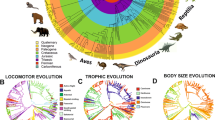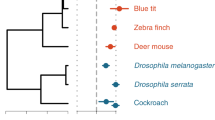Abstract
There is a widely held assumption that skeletal weights of mammals increase disproportionately with increased body size. Recent empirical studies have supported this assumption, and it has been suggested that this might account for the fact that metabolic rate scales to body weight with a negative allometry. Other studies, however, have suggested that skeletal weight in primates is directly proportionate to body weight. The results of this study support this latter interpretation and also indicate that the same is true for two other orders of mammals that were a part of the earlier allometric studies. The evidence suggests that skeletal weight scales isometricallywith body weight within individual mammalian orders. From this it is concluded that skeletal weight does not play any part in determining the negatively allometric scaling of metabolic rate.
Similar content being viewed by others
References
Alexander, R. McN., Jayes, A. G., Malom, G. M. O., and Wathuta, E. M. (1979). Allometry of the limb bones of mammals from shrews (Sorex) to elephants (Loxodonta).J. Zool. (London) 189: 305–314.
Draper, H. H., and Scythes, C. A. (1981). Calcium, phosphate and osteoporesis.Fed. Proc. 40(5): 2434–2438.
Gould, S. J. (1966). Allometry and size in ontogeny and phylogeny.Biol. Rev. 41: 587–640.
Gould, S. J. (1975). Allometry in primates, with emphasis on scaling and evolution of the brain.Contrib. Primatol. 5: 244–292.
Hladik, C. M. (1977a). A comparative study of the feeding strategies of sympatric species of leaf monkeys,Presbytis senex andPresbytis entellus. In Clutton-Brock, T. H. (ed.),Primate Ecology, Academic Press, London, pp. 324–353.
Hladik, C. M. (1977b). Chimpanzees of Gabon and chimpanzees of Gombe: Some comparative data on their diet. In Clutton-Brock, T. H. (ed.),Primate Ecology, Academic Press, London, pp. 481–501.
Kayser, C., and Heusner, H. (1964). étude comparative du metabolisme enérgetique dans la série animale.J. Physiol. (Paris) 56: 489–524.
Martin, R. D. (1980). Adaptation and body size in primates.Z. Morph. Anthropol. 71:115–124.
Martin, R. D., and MacLarnon, A. M. (1985). Gestation period, neonatal size and maternal investment in placental mammals.Nature (London) 313: 220–223.
Martin, R. D., Chivers, D. J., MacLarnon, A. M., and Hladik, C. M. (1985). Gastrointestinal allometry in primates and other mammals. In Jungers, W. L. (ed.),Size and Scaling in Primate Biology, Plenum Press, New York, pp. 61–89.
McMarhon,T.A., and Bonner, J. T. (1983).On Life and Size, W. M. Freeman, San Francisco.
Prange, M. D., Anderson, J. F., and Rann, H. (1979). Scaling of skeletal to body mass in mammals.Am. Nat. 113: 103–122.
Schmidt-Neilsen, K. (1977). Problems of scaling: Locomotion and physiological correlates. In Pedley, T. J. (ed.),Scale Effects in Animal Locomotion, Academic Press, London, pp. 1–21.
Schmidt-Neilsen, K. (1984).Scaling: Why Is Animal Size So Important? Cambridge University Press, Cambridge.
Schultz, A. H. (1962). The relative weights of the skeletal parts in adult primates.Am. J. phys. Anthrop. 20: 1–10.
Smith, A. M., and Pace, N. (1971). Differential component and organ size relationships among whales.Environ. Physiol. 1: 122–136.
Stahl, W. R., and Gummerson, J. Y. (1967). Systematic allometry in five species of adult primate.Growth 31: 313–324.
Trotter, M., and Peterson, R. (1970). Weight of the skeleton during postnatal development.Am. J. phys. Anthrop. 33: 313–324.
Ultsch, G. R. (1974). The allometric relationship between metabolic rate and body size: Role of the skeleton.Am. Midl. Nat. 92(2): 500–504.




